Suited connectors are one of those right place, right time hands that divide opinions. To play or not to play? While there are good reasons to play suited connectors, the question is, are they worth it in the end? I’ll try to answer this question in subsequent paragraphs and show you everything else you need to know about suited connectors.
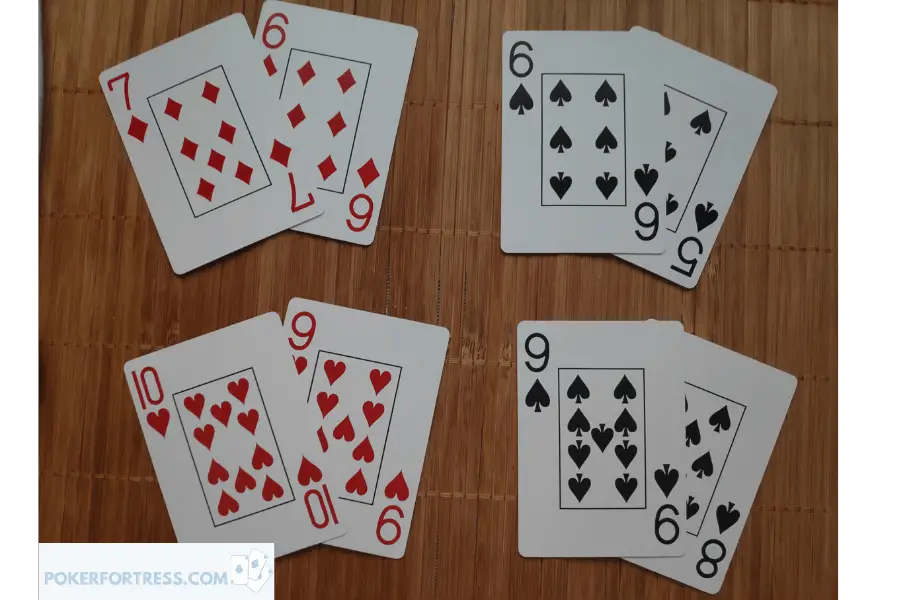
When you hear a word suited connectors, you think of cards anywhere from 65s to T9s. But technically following the rule, a suited connector is all cards from 32s up to AKs. In this article, when I will be mentioning suited connectors, I will be referring to lower suited connectors (below T9s) unless I explicitly say otherwise. With anything above that, you should be doing fine already and making a substantial profit. I will not just explain to you how you should play them and when not to. Moreover, I will show you my graph of playing them from different positions.
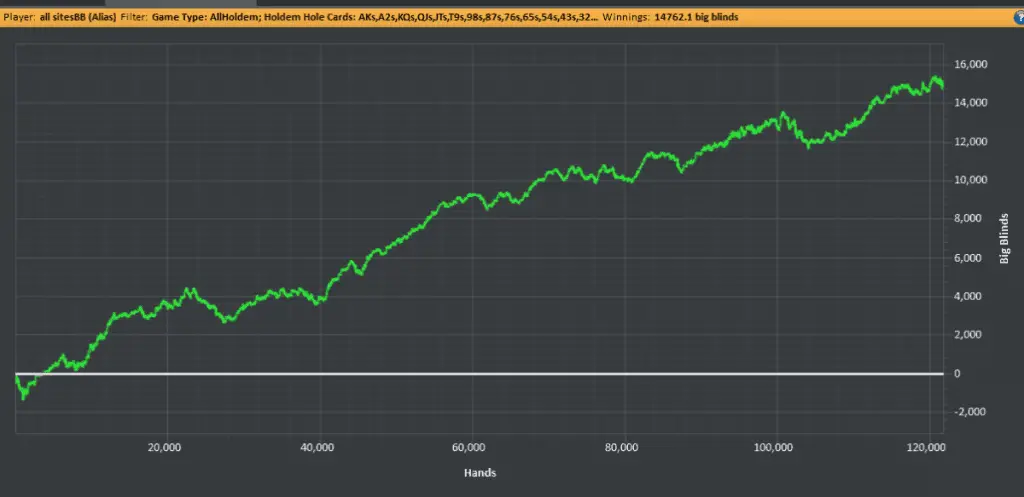
Suited connectors are a decent hand to play when you’ve got elements like position, number of players, and stack size working in your favor. If played correctly, suited connectors yield valuable returns, but when misplayed, it is sure to cost you.
Many players fold this hand because they don’t think it’s profitable, whereas adding it to their playable hands will help boost their range and winrate. Playing them means you can also credibly represent a hand on lower boards and not just give up.
Suited connectors are hands that feature the same suit cards consecutively. For example, in Texas no-limit Hold’em, you’re dealt a suited connector when the dealer deals you 7h-8h of same suits (heart). The opportunities presented by suited connectors include the possibility of gunning for a flush, a straight, or a straight flush.
Playing Suited Connectors
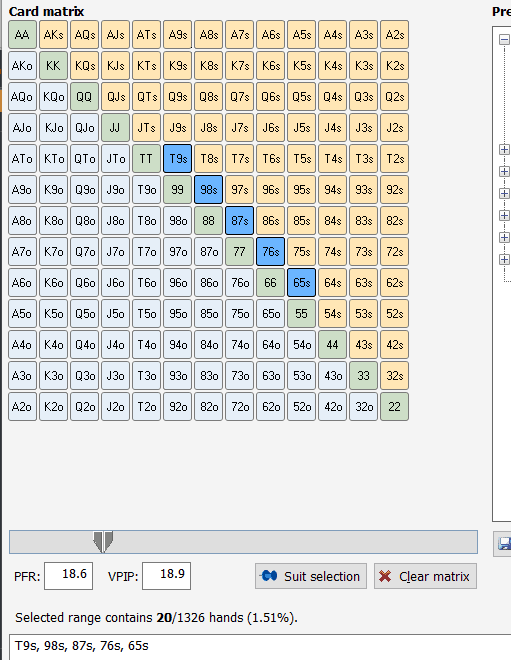
It is common to find players who are new to Texas no-limit Hold’em being choosy with their starting hands. These players prefer sticking with hands like king-queen, some suited ace rag hands, and pocket pairs, and that’s understandable because limiting yourself to solid starting hands means the probability of making worthier hands at showdown increases. It can also help reduce the number of difficult decisions you get to face during a hand (although not completely).
That said, it is not feasible to limit yourself to only the best starting hands because they don’t exactly come around as often as you would like. Playing only good starting hands in tournaments could mean having your stack gradually eaten away by the antes and blinds as you continue to fold the not so great hands you get. In cash games, you will be unknowingly decreasing your winrate by folding too much preflop or it might even turn you into a losing player.
This is something that can be easily checked in your database of hands with software like Holdem Manager. Also, playing only good starting hands makes you incredibly easy to read. Whenever you do get pocket aces or pocket kings, your opponents are going to fold when you raise, leaving you with a small pot. Sometimes it might be a good idea to add in a hand that is close to being breakeven to increase your preflop range.
So, how does a newbie get by in no-limit Hold’em? One possible way is playing suited connectors. You can fold the lowest ones (32s to 45 or 56s) and start opening from 56s or 76s onwards, depending on your position. Although they are notorious for being complicated hands, when played correctly, middle suited connectors can be hugely rewarding to your game. Hence, you can add them to starting hands you play to improve your range.
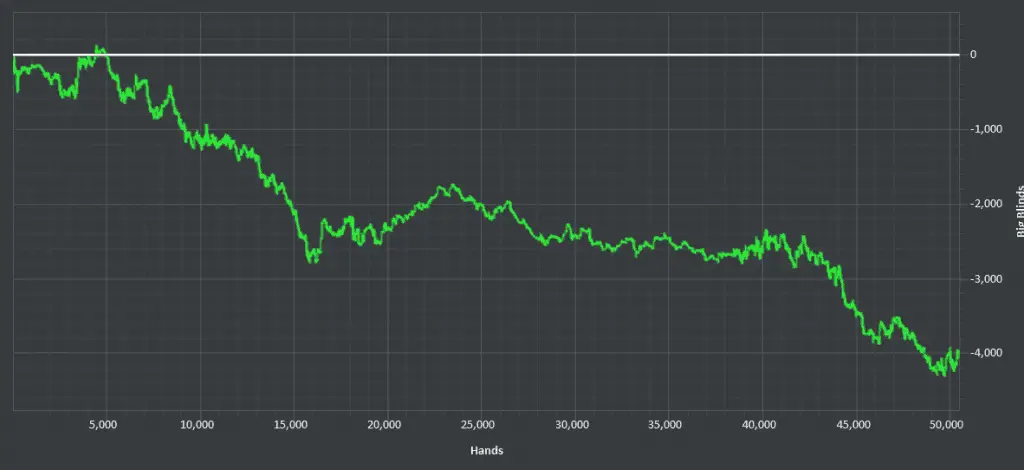
They will not improve your winrate by much if any. As you can tell from my graph, I don’t make any money with them. Even though my overall winrate is down with them, I am loosing less than I would by folding them. In 6max games, you need to pay 1.5 big blinds to post the blinds every orbit. This means by folding them every time I would be losing 30bb/100 with them. By playing them I am down less than 10bb/100. Even in full ring games, I am still doing better than I would by simply folding them. Let’s not forget about increasing our preflop range either.
If we let our opponents know we can fight back on low boards; which we certainly can if we have suited connectors in our playing range; then on other times they are more likely to check down when we don’t have a suited connector on low board.
However, before you proceed to play more suited connectors, you need to learn and master how and when to play them without getting into trouble. Playing hands for the sake of it is just as terrible as playing tightly, and I would argue than even worse. If you are tight, you will lose slowly. But if you play too many hands, you might get yourself into problems postflop.
Those problems accumulate to more significant losses on each subsequent street, and before you know it, you lost half of the stack with a hand you shouldn’t even play. Therefore, this article will be shedding light on how to play all suited connectors (and which not to) and the common mistakes people make while playing it.
There are two notable approaches most players following when playing suited connectors, the first approach has been around for quite some time, while the second approach is a bit modish. They are:
- Playing Suited Connectors Only When Your Opponents are Many:
This is the traditional approach for low-mid suited connectors. Especially popular amongst live players. According to this strategy, since such connectors are drawing hands ( they must improve to stand a chance of winning at showdown), you need to play against a large field to justify your draw’s odds coming in.
For example, if you’re dealing with an open-ended straight draw on the flop and decide to continue, there’s only about 17% chance of hitting straight on the turn, and around 32%to hit it by the river, which means you need to make a considerable amount of money when you do hit. Your huge pot on hitting justifies the number of times you’ll have to fold.
Playing them makes sense if you have opponents who are willing to pay you off lightly once you hit a strong hand. Don’t try to bluff in multiway pots, and when someone shows aggression, be sure they have something. Generally, the traditional belief is that raising 6high (56s) suited connectors up to 9 high (89s) is a bad move. This is because players tend to fold, leading to a decrease in the pot odd during a flush or straight draw on the flop.
Many players are wrong when assuming if a straight or flush is more likely to hit. Do you know the right answer? You can found out in this article.
- Play Aggressively Before the Flop
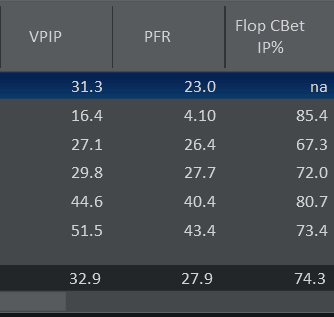
This modern approach encourages players with suited connectors to play aggressively before the flop. Calling a raise or limping often with a suited connector is seen as a wrong move. The idea behind this school of thought is that as good as suited connectors look, their value is quite low unless they’re hitting hard on the flop, which is not likely to happen often. The times when you hit a flush in a multiway pot it can easily happen, someone will hit a higher flush, and it is tough to fold flushes to river bets.
In fact, suited connectors like 9 ♥ 8 ♥ will often not hit the flop, putting you in the precarious position of being stuck with a 9 high that has no showdown value. Hence, the need to try to take control of the pot before the flop as often as possible.
Walking into the flop with a betting lead gives you the chance to win more pots without necessarily having to make the best hand. This is possible because you have a better chance to win more pots if you keep up the aggression after the flop in a bid to force your opponents to fold their hands. It is important to note that the aggressive play approach doesn’t necessarily rule out limping or calling with your suited connectors sometimes.
It merely suggests that it is more rewarding to be aggressive as often as possible. I would sometimes play low to mid suited connectors by calling preflop raises, especially if I am up against a weaker player, and I have the position over him. It must have been less than 20 times that I have limped suited connectors in my poker career in which I played over 5 million hands.
- Position
As is common knowledge in poker, the position is king in poker. The ability to act last in a hand gives you the chance to win a lot of pots without having to get to showdown. If you have been playing poker for some time, you’ll agree with me that a player is more likely to win many pots from the cutoff and button than any other position. Look at a picture of winrates by position for me from playing a mixture of 6max and FR games. I am making the most significant profits on button and cutoff.
Suited connectors are best played when you’re the last to act on a preflop round ( having position on your opponent). If you’re folded to in button or cutoff ( late positions), you could open by raising with 9 ♥ 8 ♥, which allows you to win the blinds, and antes if in a tournament, or create a scenario where you get to play against a caller in the blinds from position. When you open-raise with suited connectors, you’re able to disguise your hand since opponents will be led to believe your raise means you hold a big-card hand. Hence, you should always look to play your suited connectors when you’re in either of the two late positions mentioned above. Check my winrate for 56s-T9s in cutoff and button below. Looking at it, maybe I should work on my button strategy with them :D.
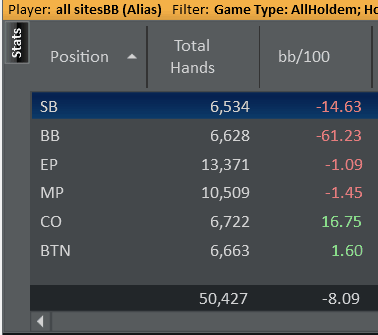
- Stack Size
Suited connectors are a hand that usually realizes its equity post-flop. It does this through semi bluffs or value bets when your hand gets there or forces your opponent to fold his/her best hand. None of these situations can be possible if you’re not sitting on a deep enough stack, which justifies your involvement.
Suited connectors don’t do well with short stacks. If your hand is 6s7s and your opponent opens from the cutoff, you can clearly tell that this means they have a better hand. Your option in this scenario is to outplay and out flop your opponent, but you’ll have your work cut out for you with the short stacks as it reduces your freedom to maneuver or fire some street as a semi-bluff.
Playing Suited Connectors in Cash Games
One of the major differences between playing suited connectors in cash games versus playing suited connectors in tournaments is that you get to play deeper stacks in cash games as opposed to tournament poker where the stacks are lower. The stack size will come in handy since suited connectors are drawing hand. Playing opponents with bigger stacks means you get to win big when you hit.
Here are a few preflop guidelines to help you play suited connectors in cash games.
- Early Position to Middle Position, Full Stacks, Full Ring: You’re better off folding them. To mix your game, you can occasionally open raise. Also, don’t call them.
- Early Position to Middle Position, Full stacks, 6-max: Again, you should fold them. You can also use them to mix your game by open-raising occasionally. Don’t call them.
- Late Position, Full Stack, Full Ring: If you’re guaranteed to get in cheaply, you can play them and push as hard as possible.
- Late Position, Full Stack, 6-max: Same as above.
Poker is a fluid game where you need to adapt to opponents and take small profitable spots if they present themselves. Especially in cash games when you can rebuy, and you are not out like in a tournament.
Exceptions to the above:
- If an awful player opens and you are very deep, I can see merit to 3bet him to get to play a pot heads up vs. him.
- I would consider calling a preflop raise with low-mid suited connectors when being very deep with a terrible player in the blinds.
Playing Suited Connectors PostFlop
Playing your suited connectors postflop is identical to playing preflop because the logic is basically the same. You can’t play your suited connectors passively and continue only when you hit a good draw or a pair. As earlier stated, hitting good draws or a pair doesn’t occur often enough for your passive play to be profitable. Usually, you’re likely to have a garbage hand when you see a flop with a suited connector. So how can you turn on profits with suited connectors? You simply need to look out for great opportunities to semi-bluff with your suited connectors.
For example, You’re raising J♦ T ♦ from a middle position, and a tight playing opponent calls from the big blind. The flop comes as A♠8♣Q♦. In this situation, if the tight player bets, you should consider raising. In this situation, you need to play aggressively with your suited connector, and double gutter draw, instead of calling. By raising in this position, you give yourself multiple ways to win the hand. You can proceed to finish your opponent off with a raise.
If the player calls, then you can easily win the pot by keeping up your aggressive play on the turn or decide to take a free card if you think he doesn’t fold often enough. This is where professional players rely heavily on the use of HUDs. If the math behind why it is better to check-raise here is unclear to you. Or you wonder why would just calling loose you money in the long term against a regular player? If that is the case, then you need to learn that. Don’t worry, it’s not scary. You can join a free poker coaching website, where odds and such play styles are explained in a simple manner.
Mistakes to Avoid While Playing Suited Connectors
Unless you play intelligently, there’s a good chance you’ll make a costly mistake while playing your suited connectors. It is this high-risk status of suited connectors that scares certain players away in the first place, but if you ever hope to become a solid player, you can’t become too bothered about the value of your hand. In the end, it will depend on how you play it. So, here are a few mistakes you should look to avoid while playing suited connectors.
- Don’t 3-bet Against Stacks of 60 big Blinds or lower
If you’re playing against an opponent who raises preflop with 60 big blinds or less in their start, you should avoid 3-betting your suited connectors especially when they are low ( 7-6, 6-5). On the other hand, when it’s a deep stack, it would make perfect sense to play your suited connectors as 3-bet bluffs. Against a short stack, the stack to pot ratio reduces implied odds and reduces your ability to maneuver post-flop. Hence, 3-betting against shorts stacks is neither rewarding or as effective as you would like. Most likely, you would be losing money if not deep enough.
- Don’t 3-bet Against Calling Stations
If you’re playing against an opponent who doesn’t fold often, then a 3-bet bluff with suited connectors isn’t going to be effective. If your opponent isn’t going to fold, there really isn’t any rewarding reason to 3-bet the hand. While this is the apparent reason why you should not 3-bet against calling stations, there’s another less apparent reason why this move is a huge mistake. Players who don’t fold often will often call your 3-bet with dominant hands like J-8 suited, K-7 suited, and A-6 suited. These hands will dominate your 8-7 suited and 6-5 suited. Such range of defending hands might crush you. In this case, our opponent has more than 63% of equity against our suited connectors. Not a good spot to be in!
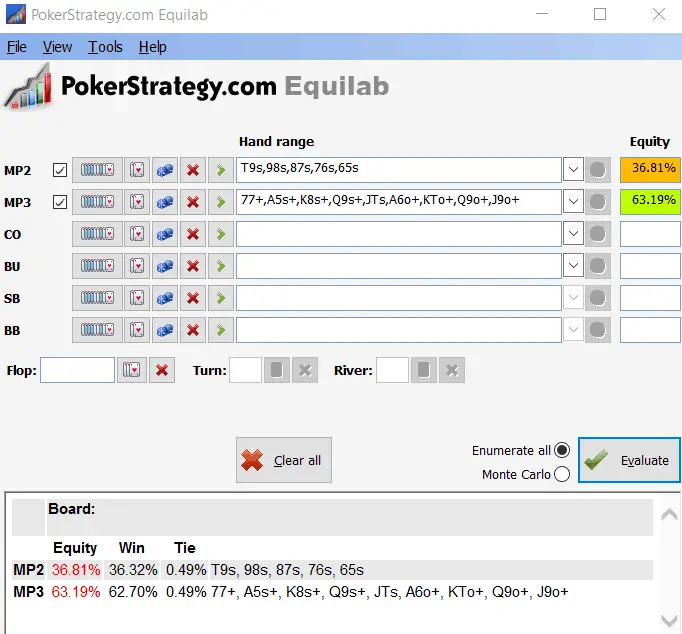
This scenario could possibly end up with the both of you hitting trips or even a flush. Against them, you should widen your 3bet value range instead and 3bet hands that are otherwise just shy of being good enough to 3bet. This one single move will increase your winrate nicely.
- 4-bet Suited Connectors Once in a While
There are 3 things to consider when trying to figure out which hand will make a good 4-bet bluff. They have implied odds, post-flop playability, and blocker effect. The blocker effect is by far the most important of the three. This is because you’re likely to encounter tight ranges in 4-bet situations, and your ability to rule out strong hands from the range of your opponent can make a huge difference. Suited Connectors feature a negative blocking effect. They block hands from an opposing player’s folding/3-bet range, such as A-6 suited or A-5 suited, and they won’t block strong hands that continue. These hands have good implied odds and solid playability, yet, they are undersized by the low stack to pot ratio in 4-bet pots.
- Unless you’re Calling From the Big Blind, Avoid Over calling
No doubt, it’s tempting to overcall with your suited connectors, but this is a potentially costly mistake unless you’re calling from the big blind. Here’s an example below to show you why you shouldn’t make this mistake.
Consider a 6-max game with everyone sitting with 100 big-blinds effective. The player in the middle position opens with 2.5 big-blinds, goes ahead to cutoff who flats and you’re sitting at the button with 6♦5♦ ready to act. Now, this is obviously a playable hand, and there’s every likelihood that you will over realize your hand’s equity, yet, you still need to look out for a squeeze behind. There’s more than 10% chance, sometimes even more than 20%, that one of the two opponents behind will 3-bet, and if that happens, you’ll be forced to fold your hand and lose your equity. There’s also a good chance the players behind will call in which case your hand’s equity reduces. These factors will leave you with a shortage of about 3 to 5 percent equity.
- Avoid Calling 3-bet Against Short Stacks
You can call 3-bets with suited connectors with deep stacks. However, their value drops massively when the stack size is reduced to 50 blinds. This usually happens because implied odds have reduced. Therefore, you will need to invest more to see a flop compared to your potential win. Now here’s the difference:
- When you’re 100 big blinds deep, you usually need to call 5–6.5 big blinds to maybe win 100 big blinds. This means you get to meet 16–20x of your preflop investment.
- When you’re 50 big blinds deep, you usually are getting the odds 5–6.5 big blinds to win 50 big blinds. This means you’re only capable of winning 7.5–10x of your original investment.
I know that if you are new to poker, all of this information is causing your brain to explode. The best approach is to incorporate parts of a new strategy into your gameplay gradually. Even better would be to join a coaching website, like this one. It is free, and there you can practice with many quizzes and ask any questions you might have on the forums. Moreover, you can join live group coachings for free.
Are Suited Connectors Worth Playing?
Suited connectors can produce a nice payout if you play them well. However, suited connectors aren’t great hands; playing them properly can prove quite tricky. They need to be played from the right position, at the right time and with a deep stack. It is, therefore, no surprise that many players fold suited connectors.
Should you fold them too? I don’t think so. Playing suited connectors can be good news for your range and your image. There is also the chance of hitting straight or flush. The only problem I think is playing suited connectors too often. If you mix it up every now and then, you should be fine. Therefore, before playing suited connectors, you need to ask if it is worth playing in that scenario. For example, when you’re under the gun, are suited connectors worth playing? No! When you’re in the button, should you play suited connectors? Yes! Hence, the answer is yes. Suited connectors are worth playing of the elements are right.
I play suited connectors around one-third of the time, through a mix of 6max and full ring games. While this number is probably close to 100% on the button if it is unopened to me, it is a lot lower in the early position.
Conclusion
Suited connectors are not strong hands, but they’re not terrible hands either. There are many experienced poker players who play these hands, and they do just fine. Your aim should be to master how to play suited connectors correctly so you can play them in a more profitable way. With the information above, you should be able to play suited connectors without much hassle.



